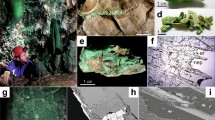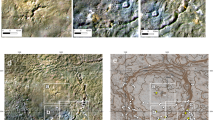Abstract
This paper examines the cause of color variations of trachytic pumices which are essentially uniform in chemical composition and proposes a geological model for their formation. A pyroclastic sequence of distinct subunits with brown, buff, and black pumices was deposited during the 5000-B.P. eruption of a tuff ring in the central Meidob volcanic field (Sudan). Subunits of buff pumices locally contain minor amounts of streaky pumice with pale-gray and dark-gray domains. The combined evidence of petrographic studies, chemical analyses of whole pumices and groundmass separates, electron microprobe analyses, optical spectroscopy, transmission electron microscopy, and magnetic susceptibility measurements show that color variations of the pumice clasts are related to the size and distribution of Fe3+-rich oxide microcrysts. Buff pumice and light-gray domains of streaky pumice have a colorless, transparent groundmass with very few microcrysts. Dark-gray domains of streaky pumice contain abundant hematite and/or magnetite microcrysts visible in thin section within a transparent, colorless glass groundmass. The groundmass of the black pumice clasts is brown in thin section which is most likely caused by submicroscopic magnetite microcrysts. Brown pumice clasts have a mixed groundmass consisting of brown domains and domains with opaque microcrysts in transparent glass. Variations in the eruption dynamics have been inferred from lithological observations. Subunits of black pumices are related to eruption pulses with low magma discharge and high water/magma mass ratio, whereas subunits of buff pumice were deposited during eruption pulses with high magma discharge and low water/magma mass ratio. Brown pumices represent the top part of the magma body, and the initial stage of the eruption probably had a low magma discharge. Streaky pumices are interpreted as the product of syn-eruptive mixing of Fe3+-rich oxide microcryst-bearing magma and microcryst-free magma.
Similar content being viewed by others
Author information
Authors and Affiliations
Additional information
Received: 3 February 1997 / Accepted: 28 July 1997
Rights and permissions
About this article
Cite this article
Paulick, H., Franz, G. The color of pumice: case study on a trachytic fall deposit, Meidob volcanic field, Sudan. Bull Volcanol 59, 171–185 (1997). https://doi.org/10.1007/s004450050184
Issue Date:
DOI: https://doi.org/10.1007/s004450050184




